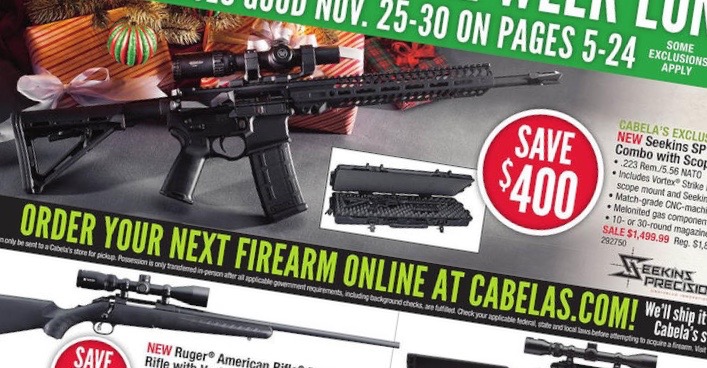The gun industry will convene Tuesday in Las Vegas for its annual trade exposition, the National Shooting Sport Foundation’s SHOT Show, as an unprecedented 19-month stretch of record-breaking sales estimates grinds to a halt. The event should offer a stark contrast to last year’s convention, where firearms makers enjoyed a comfortable boom in profits powered by a fear of impending gun restrictions at the hands of Democratic politicians, including President Barack Obama, Democratic presidential hopeful Hillary Clinton, and Governor Jerry Brown of California.
With Donald Trump’s ascendency to the White House removing the specter of new federal regulations, experts say firearms businesses may face stiffer internal competition than at any time in nearly a decade.
“It’s a very uncertain environment right now,” said Chris Krueger, an equity analyst at Lake Street Capital who covers gun stocks including American Outdoor Brands Corporation, the newly renamed parent company of Smith & Wesson.
Krueger and other experts believe that gun makers will enter the post-Obama era by expanding their range of products in the fastest-growing categories of firearms: military-style rifles and handguns designed for concealed carry. Gunmakers may also ramp up aggressive promotional efforts that play on customers’ fears of crime and terrorism, rather than fears of political change, and discount inventory to incentivize buying, they say.
Mossberg, a company best known for its traditional shotguns, announced earlier this month that it had hired a new ad agency to revamp its image. Instead of relying on messaging focused on recreation or hunting, the new campaign will stress self-defense. “Bad Guys Don’t Ring Doorbells,” reads one new tagline.
Savage Arms, a brand that has focused on traditional bolt-action hunting rifles, is making a similar move. The company debuted its first AR-15-style rifle in December.
For companies with an existing portfolio of guns designed for self-defense, fresh types of existing products can help sustain demand, according to Rob Southwick, whose firm Southwick Associates conducts market research for the outdoors industry.
“Smart companies will debut new products to keep the customer’s attention,” he said.
Many of the new firearms entering the market are essentially variations of weapons that have been around in one form or another since the 1980s, when Glock first introduced its polymer-handled semiautomatic pistols and assault-style rifles became widely available to civilians. Glock, in particular, has drawn a host of competitors, especially as state laws pushed by National Rifle Association have made it easier to carry concealed handguns in public and stoked the market for products suiting that purpose.
In early January, Smith & Wesson unveiled a new version of its wildly popular M&P semiautomatic pistol, a handgun with a polymer body marketed both to law enforcement officers and civilians interested in self-defense. In late 2016, Czech gunmaker CZ released a similar pistol, the P-10C. The prominent gun writer Bob Owens described the weapon as a potential “Glock-killer.”
During the lead-up to the presidential election, major gun companies joined forces with the NRA to depict a potential Clinton victory as a threat to firearms ownership. Sturm, Ruger & Co., for example, promised to donate up to $5 million to the NRA to help defeat Clinton, calling on “all freedom-loving Americans to take action in support of the Second Amendment.” One of the actions that some took was to buy more guns.
Larry Keane, the general counsel for the National Shooting Sports Foundation, told NBC News last week that he expects “fewer spikes in sales” in 2017.
Industry observers agree with his assessment, doubting that gun companies’ tactical shifts can sustain the boom times that they enjoyed for the past two years.
“The public in general is not as fearful of firearms rights being restricted, so there will be less panic buying,” Southwick said. “It looks like the market’s calming down a little bit and we’ll get to a new normal. I expect things to be a little more sane.”
December was the first month since May 2015 not to set a year-over-year record for volume of background checks conducted by the FBI’s National Instant Criminal Background Check System, the most accurate proxy for gun sales. Analysts believe that the soaring number of transactions seen during that period were unsustainable, driven as they were by the political cycle.
“A lot of people who were prepared to buy, say, a military-style rifle if Hillary Clinton won are now saying there’s no sense of urgency,” Krueger said.
A similar dynamic is at work at the state level in California, home to the nation’s largest individual consumer market. Last July, Brown, the state’s Democratic governor, signed a package of strict new gun laws — including an expansion of that state’s already-stringent assault weapons law — that came into effect January 1. The new restrictions severely curtail the kind of semiautomatic rifles with detachable magazines that can be sold in the country’s most populous state.
In the months before the expanded regulations went into effect, California gun buyers rushed to get their hands on weapons like the AR-15. The FBI processed more than 93,000 checks on long gun sales in the state last month, nearly double the 48,000 processed in December 2015. In the category of products that includes receivers (the part of a semiautomatic rifle that receives ammunition and is often the base for customized AR-15s), the FBI saw background checks in California jump from just shy of 10,000 in December 2015 to almost 78,000 in the last month of 2016.
Now that the new laws are actually in effect, California gun owners are effectively cut off from access to one of the gun industry’s mainstay products.
Krueger, the Lake Street Capital analyst, said that when he gets to Las Vegas for the SHOT Show, he will be on the look-out for signs of just how much leaner gun companies expect business to get. The big question he’ll be asking at the convention hall is “whether it’s one tough year before things begin to stabilize, or multiple tough years.”

